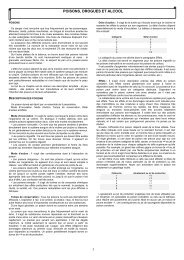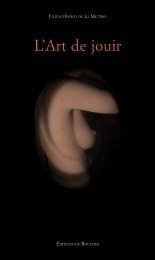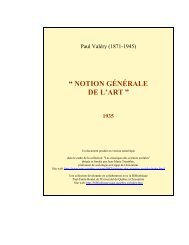Intervenir en public - z
Intervenir en public - z
Intervenir en public - z
- No tags were found...
You also want an ePaper? Increase the reach of your titles
YUMPU automatically turns print PDFs into web optimized ePapers that Google loves.
~Grant eligibility in year t and all stud<strong>en</strong>ts with E 0 are ineligible for Pell Grants. 16 FigureFC it3 displays the empirical distribution of Pell Grant aid by standardized EFC. 17Consider the following first stage and reduced form equations:~~(3) Pellit 1EFCit 0EFCit1EFCit 0 [ EFCit ] jtijty(4) ijtit it ititj t ijt~~~ ~~ 1EFC 0 EFC 1EFC 0 [ EFC] Here, i indexes stud<strong>en</strong>ts, j indexes institutions, and t indexes years. Pell is the Pell Grant awardreceived by stud<strong>en</strong>t i in year t with an expected family contribution of EFC it , and y ijt is the~outcome of interest, institutional aid. The term1EFC it 0is an indicator for Pell Granteligibility and ρ indexes the degree of polynomial in the assignm<strong>en</strong>t variable, E ~~itFCit. I includeyear and school fixed effects to reduce residual variation; these terms are not necessary forid<strong>en</strong>tification. I also include a vector of stud<strong>en</strong>t characteristics for this reason. 18 The ratio of the~reduced form and first-stage coeffici<strong>en</strong>ts for the interaction betwe<strong>en</strong> 1 EFC it 0and the linearterm in E ~ , ˆ FCitRKˆ , repres<strong>en</strong>ts the RK estimate of the impact of Pell Grant aid onˆ institutional aid (i.e., the change in the slope of the conditional expectation at the cut-off servesas an instrum<strong>en</strong>t for Pell g<strong>en</strong>erosity). Likewise, the ratio of the reduced form and first-stageˆ coeffici<strong>en</strong>ts for Pell Grant eligibility, ˆ RD , repres<strong>en</strong>ts the RD estimate of the impact of Pellˆ Grant aid on institutional aid.To further illustrate the mechanics of this framework, Figures 4A and 4B illustratepot<strong>en</strong>tial behavior of the relationship betwe<strong>en</strong> institutional aid and EFC near the eligibility16 For the years I examine, efc 0t equals $2140 (1996), $2925 (2000), $3850 (2004), and $4110 (2008).17 In a giv<strong>en</strong> year, the kink and discontinuity in the relationship betwe<strong>en</strong> Pell Grant aid and EFC occur at slightlydiffer<strong>en</strong>t values of EFC. However, the distance betwe<strong>en</strong> these points is quite small and only a small fraction ofstud<strong>en</strong>ts have an EFC falling on this “plateau” (Figures 3). For the remainder of the paper, I treat both the slope andthe level of Pell Grant funding changes as occurring at the eligibility cut-off. My results are robust to removingstud<strong>en</strong>ts whose EFC falls on the plateau (forcing the discontinuity and kink to occur at the same value of EFC).18 Stud<strong>en</strong>t characteristics include g<strong>en</strong>der, race, citiz<strong>en</strong>ship, level (e.g., whether the stud<strong>en</strong>t is a first year, secondyear, etc.), a quadratic in age, indicators for full time and full year <strong>en</strong>rollm<strong>en</strong>t, and whether the stud<strong>en</strong>t qualified asin jurisdiction for tuition purposes.11









